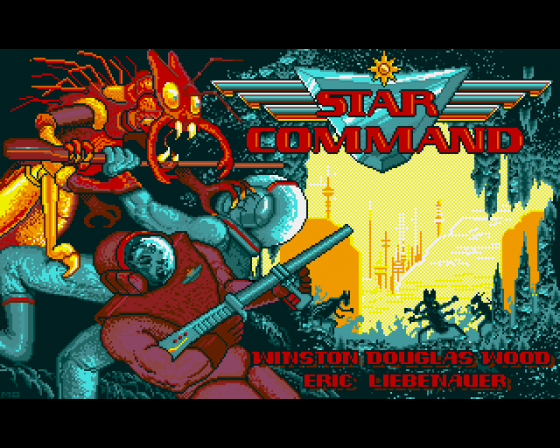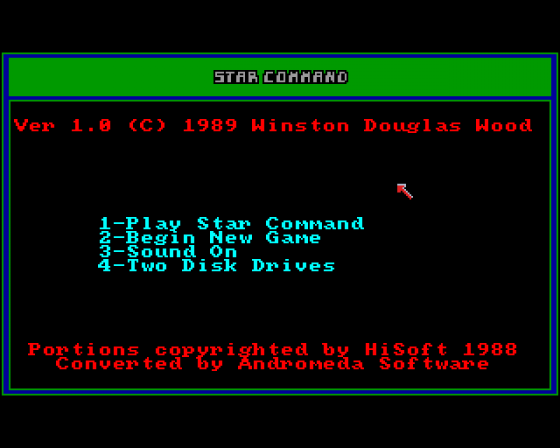
Zzap
 1st December 1989
1st December 1989
Star Command
Stuart's log, Stardate 1259pm. After being beamed down into The Prometheus Prophecy last month, the dastardly Dr Norman Nutz has now stranded me on a space station in the Triangle. After accidentally being sold off in last month's Classified, he claims he hasn't time to explore this Amiga release. And in any case thinks a non-RPG fan's opinion would be useful to people who haven't played this sort of game before, so here's the idiot's guide to... SSI's Star Command.
"Why read science fiction when you can *live* it?" demands the packaging: a provocative statement to me and I soon set about reading the 28-page manual. With six pages devoted to charts showing hardware available and such like, the manual seems relatively small, but it's densely packed with how-to-play stuff and not an easy read.
The scenario is surprisingly brief, about a page, and tells us the Triangle is the shape and name of Mankind's space empire. Its borders are the Alpha frontier (dominated by piracy under Blackbeard), Beta Frontier (intelligent insects planning a war) and the Unknown. You're in command of a crew of eight which must complete the various missions assigned to you. Many arcade games have better and more realistic settings than this!
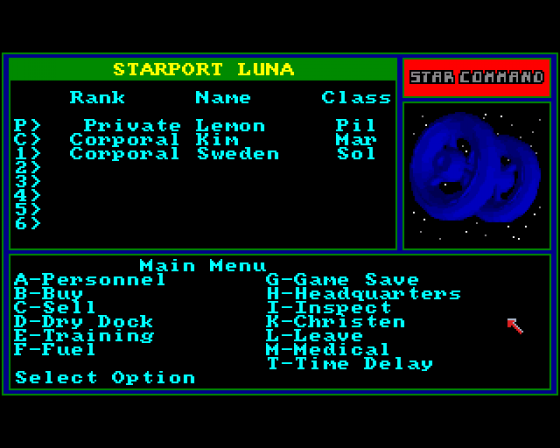
Once you begin the game, you must assemble your crew. All instructions are key presses to select options. Despite the mouse arrow on screen, there's no WIMP system. Crew selection begins with you pressing 'A', and a character's seven attributes are soon displayed. Attributes range from strength to speed to intelligence. Some attributes overlap, both courage and accuracy affect aiming in battle.
If you like a character's attributes you can hire him, if not you go onto the next. Hire a character and you can train him as a Marine (useful for espionage missions), a Soldier (Explosives and Chemical weapons option), Pilot (fly ship and communicate with aliens), and Esper (psi healing and attack).
To train a character you select a subject (i.e. Light Arms) and if you're lucky he'll go up a notch in that subject. Level eight is the highest you can go in a subject, and you have eight years to train someone. This might mean one year Light Arms, two years Special Forces (improving speed and accuracy attributes), one year Scouting/Recon, one year medical, one your explosives, and one year repairs. You can also go to officer school, and there are thirteen ranks from private to grand admiral with widely varying earnings.
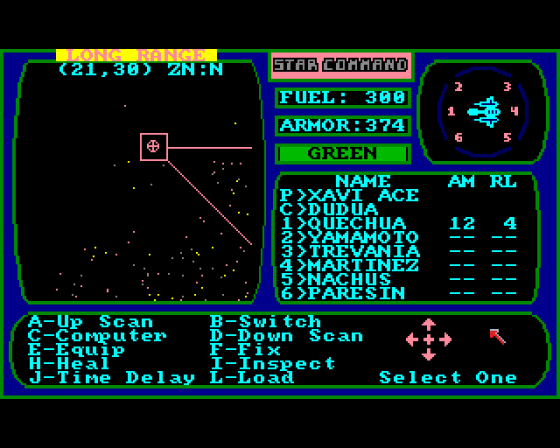
As a consequence when someone fires at an enemy the computer takes account of the weapon, whether it's loaded range, any aiming devices added on, the soldier's accuracy, courage and willpower attributes, plus training rank with weapon type. Each time you complete a mission, you can return to training to improve selected attributes/skills further.
Once you've picked your crew you should pick a starship. There's a big range, but they're expensive, limiting choice to two initially. Choose the cheapest as you also need to buy defensive equipment (shields, armour and later, electronic gadgets), ship's weapons (a large range) and crew equipment. Your team has a massive choice of weapons (5.56mm Palm Guns to Neutron Grenades), plus protective clothing and miscellaneous stuff such as Medikits, radiation detectors, and lockpick sets.
Now you're all kitted up, you can get a mission from Headquarters and set off. My first mission was to go a set zone, and conduct espionage missions on all the planets there. In essence this meant moving a cursor across a plain space map until said zone was reached, then stepping down the map scale to show all the stars in the zone, I then moved the cursor to the nearest star, stepped down the map scale, and moved the cursor to the nearest planet. Map scale is scaled down to show a piccy of the planet, and a mission (either espionage, trade or scientific) is selected. A dropship is shown flying off, then returns. Pretty boring, huh?
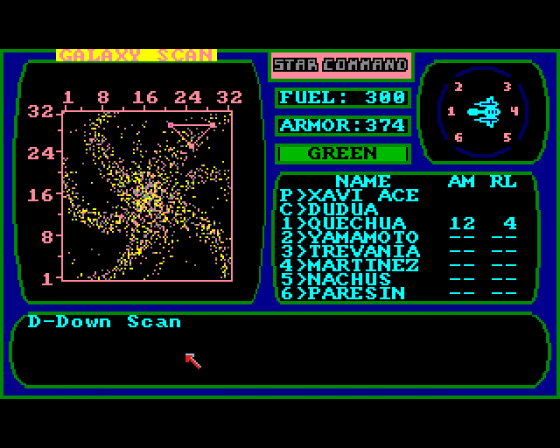
Of course, it takes time to get into the game, and soon enough space combat had begun. The first phase of combat is communication where you can, for example, plead for a truce or even pretend to be a deity and demand the enemy surrender. Phase two is movement. Your rather pathetic ship icon (it resembles a stick man! - Norman) can be moved around or rotated. The latter is important because which direction shields, and gun positions, face is crucial. Phase three is firing, the computer suggests targets, but can change them or not fire at all.
Choose fire, and a laser beam flies off, it's course and impact determined by weapon type, the gunner's skill and so on. As important as tactics in battle, is the planning of the ship's defences; which weapons are where and so on.
If you've planned well you can badly damage the enemy and choose to board his vessel. Squad combat then begins: this is basically the game whether on an enemy ship, space station or planet. The view switches to show the combat zone, from above, and details of your squad's health. The environment is divided up into empty areas, impassable areas, and defensive or offensive areas. Combat is again divided up into communications, movement and shooting phases. The squad always moves together and occasionally you can stumble over a computer, allowing you to scan its memory etc.

Presentation throughout the game is crude and unattractive. Using the mouse to point and click on a nicely designed layout would've added a lot. The basics of gameplay are surprisingly simple, but killing someone involves so much (skill, character attributes, choice of dozens of weapons etc) that it's far from easy to play.
Appropriate enough for something which claims to be like a book, the reward of playing the game isn't so much spectacular space battle scenes but the gradual development of the adventure. Your squad builds up its skills (and if you lose a man you might clone him, expensive as it is). The missions gradually becomes more interesting, and clearly there's a lot of memory to provide a big variety.
If I had more spare time, Star Command offers the sort of challenge most arcade games couldn't dream of matching (though FOFT has a go). It is, in a very limited sense, like being in a book. But you must use your imagination a heckuva lot to get over the poor presentation.
According to Robin, this is only an average example of the game-type, so I'll be looking out for some of the better ones (Oh no, you won't! - Norman)
Scores
Amiga 500 Version| Atmosphere | 48% |
| Interaction | 44% |
| Lastability | 68% |
| Overall | 52% |


